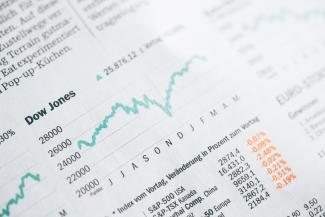
Portfolio Performance: Choose Your Benchmarks Wisely
Dramatic market turbulence has been common in 2020, and you can't help but hear about the frequent ups and downs of the Dow Jones Industrial Average or the S&P 500 index. The performance of these major indexes is widely reported and analyzed in detail by financial news outlets around the nation.
Both the Dow and the S&P 500 track the stocks of large domestic companies. But with about 500 stocks compared to the Dow's 30, the S&P 500 comprises a much broader segment of the market and is considered to be representative of U.S. stocks in general. These indexes are useful tools for tracking stock market trends; however, some investors mistakenly think of them as benchmarks for the performance of their own portfolios
It doesn't make sense to compare a broadly diversified, multi-asset portfolio to just one of its own components. Expecting portfolio returns to meet or beat "the market" in good times is usually unrealistic, unless you are willing to expose 100% of your savings to the risk and volatility associated with stock investments. On the other hand, if you have a well-diversified portfolio, you might be happy to see that your portfolio doesn't lose as much as the market when stocks are falling.
Asset Allocation: It’s Personal
Investor portfolios are typically divided among asset classes that tend to perform differently under different market conditions. An appropriate mix of stocks, bonds, and other investments depends on the investor's age, risk tolerance, and financial goals.
Consequently, there may not be a single benchmark that matches your actual holdings and the composition of your individual portfolio. It could take a combination of several benchmarks to provide a meaningful performance picture. There are hundreds of indexes based on a wide variety of markets (domestic/foreign), asset classes (stocks/bonds), market segments (large cap/small cap), styles (growth/value), and other criteria.
Keep The Proper Perspective
Seasoned investors understand that short-term results may have little to do with the effectiveness of a long-term investment strategy. Even so, the desire to become a more disciplined investor is often tested by the arrival of your account statements.
Making decisions based on last year's — or last month's — performance figures may not be wise, because asset classes, market segments, and industries do not always perform the same from one period to the next. When an investment experiences dramatic upside performance, much of the opportunity for market gains may have already passed. Conversely, moving out of an investment when it has a down period could take you out of a position to benefit when that market segment starts to recover.
There's nothing you can do about global economic conditions or the level of returns delivered by the financial markets, but you can control the composition of your portfolio. Evaluating investment results through the correct lens may help you make appropriate adjustments and plan effectively for the future.
The performance of an unmanaged index is not indicative of the performance of any specific security, and individuals cannot invest directly in an index. Asset allocation and diversification are methods used to help manage investment risk; they do not guarantee a profit or protect against investment loss. All investments are subject to market fluctuation, risk, and loss of principal. Shares, when sold, may be worth more or less than their original cost. Investments that seek a higher return tend to involve greater risk.

